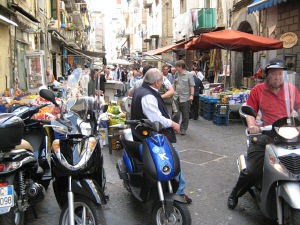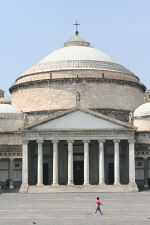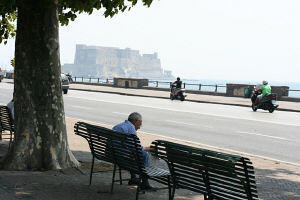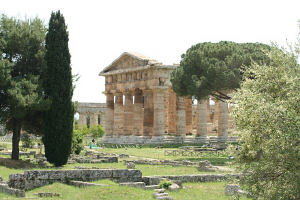Naples
 It’s a given you love Italy. The food, the wine, the people – not to mention the culture, history, and art – make it one of the most desirable vacation spots in the world. And although Northerners scoff there is nothing south of Rome, in all the ways we love Italy the southern capital of Naples holds its own and then some.
It’s a given you love Italy. The food, the wine, the people – not to mention the culture, history, and art – make it one of the most desirable vacation spots in the world. And although Northerners scoff there is nothing south of Rome, in all the ways we love Italy the southern capital of Naples holds its own and then some.
Bella Napoli may seem a more apt sentiment for an era long since passed, but the aging beauty hasn’t completely succumbed to the ravages of history, politics, and crime. Less than two hours from Rome, this port city founded by the Greeks (Neapolis) and expanded by the Romans will be unlike any other Italian city you have visited thus far. Here, life takes place at full throttle. Mini-operettas take place on every street corner, while flashing Vespas scoot across pedestrian piazzas. Small, narrow streets hung thick with laundry are covered in exhaust pouring from a passing bus. You may wonder how clothes in Naples ever come clean.

An aperitivo taken at Café Gambrinus, the city’s oldest and most elegant café will almost certainly restore your faith. Set on the corner of the Piazza del Plebiscito, the café is in a fine position for the leisurely pursuit of people watching, or for those with an agenda, it is an excellent starting point for exploring the city. But fair warning, drinks on the terrace will cost you!
Quick links to Naples travel resources:
- How to Find Cheap Airfare to Naples
- Where to Stay in Naples
- Things You Should Know About Naples
- Top 10 Things to Do in Naples
- Free Things to Do in Naples
- Day Trips from Naples
- Best Naples Pizza (Besides the “Eat Pray Love” One)
>> And if you’re curious about Naples but not sure you want to brave it alone – or if you just want to make your stay as efficient as possible – then hiring a Naples tour guide is always a good idea. I spent an afternoon with one passionate Naples tour guide, who I’d recommend to readers.
Where to Stay in Naples
Naples is a big and sprawling city, and there are plenty of areas of the city that have hotels and hostels – but it’s also a city that can be a shock to the senses, so unless you’re really familiar with Naples and know how to get around I’d suggest sticking to the historic center for your accommodation options.
If you’re traveling on a budget, you’ll notice that many of the cheaper places to stay are located right around the square in front of the main train station. It’s true that this area is convenient if you’ve got an early train to your next destination the next morning, but I’d still advise against staying around the station if you can avoid it. The true historic center has enough hotels and hostels that are reasonably-priced to make it a better choice for most travelers, in my opinion.
Here are some links to help you find a place to stay in Naples.
- Budget Hotels in Naples’ Historic Center
- Cheap Hotels in Naples
- Hostels in Naples City Center
- Apartment Rentals in Naples
What To Do In Naples
From volcanoes to pizza, Naples truly offers a little something for everyone. The historic center can be crowded and chaotic, but the local color is what you came for. Soak it all in with a stroll down Spaccanapoli (literally ‘split Naples’ because it cuts the city in half). In the end, you might be surprised at just how tourist friendly Naples can be.
- National Archaeological Museum of Naples – Inside you’ll find one of the most remarkable collections of ancient exhibits in the world. In addition to the coveted Farnese collection, the museum boasts objects taken from nearby Pompeii and Herculaneum. There is even a secret room (although well marked) which holds a collection of erotic artifacts that, depending on your modesty level, will either thrill you or make you blush – or perhaps a bit of both!
 Church of San Francesco di Paola – Often compared to Rome’s Pantheon, the Church of San Francesco di Paola (pictured at the right) is fronted by a portico resting on six columns and two Ionic pillars.
Church of San Francesco di Paola – Often compared to Rome’s Pantheon, the Church of San Francesco di Paola (pictured at the right) is fronted by a portico resting on six columns and two Ionic pillars.- Palazzo Reale (Royal Palace) – The Museum of the Historical Apartments on the first floor is an ‘open house’ for those who desire to know how the rich and royal Bourbon rulers furnished their homes during the Kingdom of the Two Sicilies.
- San Carlo Theater – The oldest working theater in Europe, the beautiful San Carlo Theater is also Italy’s largest. Guided tours are available for those who can’t snag an opera ticket, but still want to oggle the opulently gilded interior.
- Napoli Sotterranea (Naples Underground) – Discover a hidden world of caverns and tunnels burrowed under the city with the Associazione Napoli Sotterranea. But bring a jacket; it can get cold down there!
- Il Duomo (The Cathedral) – Dedicated to Our Lady of Assumption, the Cathedral of Naples resides on an area of the Greek-Roman city that was occupied by the basilicas of Saint Restituta and Saint Stefania. Although originally built in the Gothic style, much of it has been lost to reconstruction and renovation. Inside the cathedral are two vials of Saint Gennaro’s blood (Naples Patron Saint). Twice a year they miraculously liquefy to the great relief of the citizens who believe failing to do so is a sign the city is in grave danger.
 Castles – Naples hosts 3 castles worth a look. The 12th century Castel dell’Ovo (Egg Castle), dominates the Neapolitan seafront from its island position (that’s the Castel dell’Ovo in the background of the picture to the right). Castel Nuovo (New Castle) overlooking the port, was built by Charles I of Anjou towards the end of the 13th century. Castel Sant’Elmo, standing high over the city, offers panoramic views from its ramparts and forts to the bay below.
Castles – Naples hosts 3 castles worth a look. The 12th century Castel dell’Ovo (Egg Castle), dominates the Neapolitan seafront from its island position (that’s the Castel dell’Ovo in the background of the picture to the right). Castel Nuovo (New Castle) overlooking the port, was built by Charles I of Anjou towards the end of the 13th century. Castel Sant’Elmo, standing high over the city, offers panoramic views from its ramparts and forts to the bay below.- Cappella Sansevero – This intimate family chapel houses one of the most famous statues in the world, Christ Veiled Under a Shroud (or Veiled Christ). It is an intense life-like carving that will force you to take a closer look. Did the frozen form of Christ just take a breath?
>> You can always hire a guide to show you around, as well – I spent some time with this Naples tour guide, and recommend her.
What To Do Around Naples
Even the most die-hard Naples fans might need a break from the city after a couple days, and thankfully there are plenty of places around Naples that are perfect for day trips.
- Pompeii and Herculaneum – The infamous Roman cities laid to waste by Mount Vesuvius in 79 AD can easily be visited from downtown using the Circumvesuviana Railway, are open daily, and offer an exciting glimpse into life almost 2,000 years ago. Read more about the history of Pompeii and Herculaneum, and then get tips on how to visit Pompeii and how to visit Herculaneum.
 Isle of Capri – Call it anything but KAH-pree and you’ll risk the wrath of the locals! This charming island has been lulling famous holiday makers for centuries. Day trips can be easily had from Sorrento or Naples. (Capri is pictured to the right.)
Isle of Capri – Call it anything but KAH-pree and you’ll risk the wrath of the locals! This charming island has been lulling famous holiday makers for centuries. Day trips can be easily had from Sorrento or Naples. (Capri is pictured to the right.)- Sorrento & Costiera Amalfitana (Amalfi Coast) – Most travelers who make it south of Rome have Sorrento and the Amalfi Coast on their itinerary. And rightly so: in less than an hour, the chaos and confusion of Naples give way to rugged coastlines and raw scenic beauty. From Positano to Vietri sul Mare, the Amalfi Coast drive offers terraced lemon and olive groves, picturesque towns, and jaw-dropping views. No wonder this area was named a UNESCO World Heritage Site.
>> Learn more about how to get from Naples to Sorrento - Mount Vesuvius – Stretch your legs and work off some of that famous Neapolitan Pizza with a trek up Mount Vesuvius. Responsible for the destruction of Pompeii and Herculaneum, Mount Vesuvius is regarded as one of the world’s most dangerous volcanoes.
 Paestum – The Greek temples of Paestum, dating from the first half of the 6th century BC, could very well be the best preserved in the world. The surrounding walls are certainly the most complete from that period. Set in the countryside near the coast and completely off the beaten path, Paestum offers quiet moments not easily found at either Pompeii or Herculaneum.
Paestum – The Greek temples of Paestum, dating from the first half of the 6th century BC, could very well be the best preserved in the world. The surrounding walls are certainly the most complete from that period. Set in the countryside near the coast and completely off the beaten path, Paestum offers quiet moments not easily found at either Pompeii or Herculaneum.
For additional Tourist Information from the Azienda Autonoma Soggiorno Cura e Turismo di Napoli visit the web site www.inaples.it. Download a free copy of Qui Napoli, the most complete guide to current events in Naples. Visitors in Naples can pick up complimentary copies at local tourist offices throughout the city.
The author of this page, Karen Landes, spent two years exploring Sicily. Read more about her island discoveries in her new book, “In Etna’s Shadow: Culinary Adventures from Eastern Sicily.” Today she and her family live outside of Naples, Italy. She can be found online at www.inetnasshadow.com and www.southofrome.com.